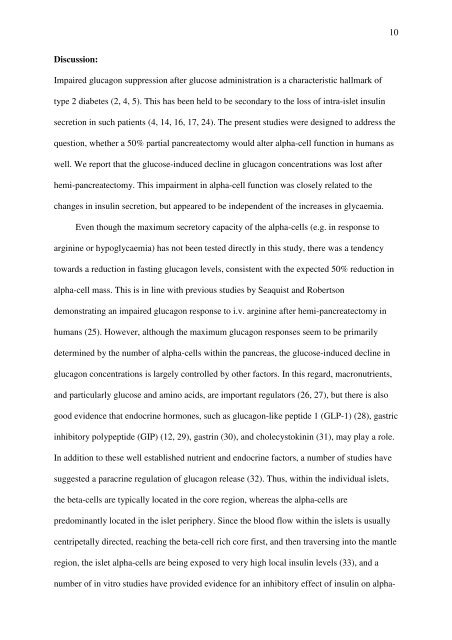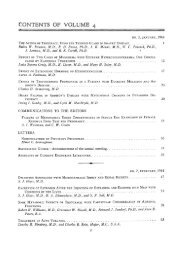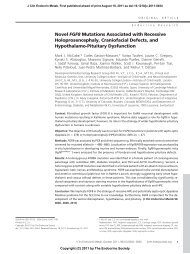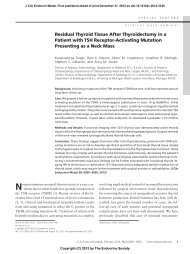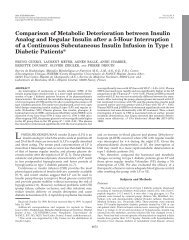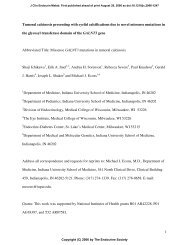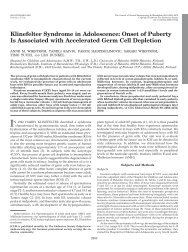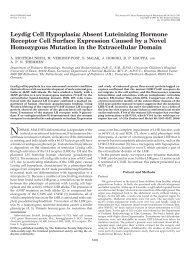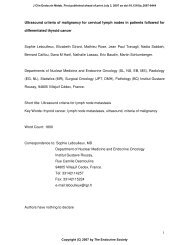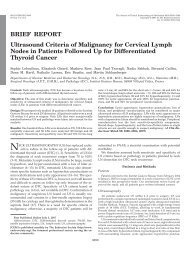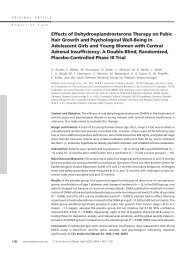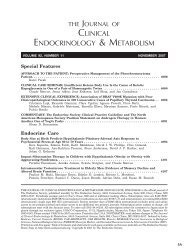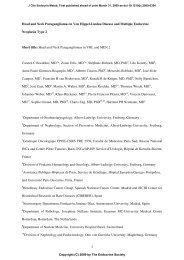Impaired glucose-induced glucagon suppression after partial ...
Impaired glucose-induced glucagon suppression after partial ...
Impaired glucose-induced glucagon suppression after partial ...
You also want an ePaper? Increase the reach of your titles
YUMPU automatically turns print PDFs into web optimized ePapers that Google loves.
Discussion:<br />
<strong>Impaired</strong> <strong>glucagon</strong> <strong>suppression</strong> <strong>after</strong> <strong>glucose</strong> administration is a characteristic hallmark of<br />
type 2 diabetes (2, 4, 5). This has been held to be secondary to the loss of intra-islet insulin<br />
secretion in such patients (4, 14, 16, 17, 24). The present studies were designed to address the<br />
question, whether a 50% <strong>partial</strong> pancreatectomy would alter alpha-cell function in humans as<br />
well. We report that the <strong>glucose</strong>-<strong>induced</strong> decline in <strong>glucagon</strong> concentrations was lost <strong>after</strong><br />
hemi-pancreatectomy. This impairment in alpha-cell function was closely related to the<br />
changes in insulin secretion, but appeared to be independent of the increases in glycaemia.<br />
Even though the maximum secretory capacity of the alpha-cells (e.g. in response to<br />
arginine or hypoglycaemia) has not been tested directly in this study, there was a tendency<br />
towards a reduction in fasting <strong>glucagon</strong> levels, consistent with the expected 50% reduction in<br />
alpha-cell mass. This is in line with previous studies by Seaquist and Robertson<br />
demonstrating an impaired <strong>glucagon</strong> response to i.v. arginine <strong>after</strong> hemi-pancreatectomy in<br />
humans (25). However, although the maximum <strong>glucagon</strong> responses seem to be primarily<br />
determined by the number of alpha-cells within the pancreas, the <strong>glucose</strong>-<strong>induced</strong> decline in<br />
<strong>glucagon</strong> concentrations is largely controlled by other factors. In this regard, macronutrients,<br />
and particularly <strong>glucose</strong> and amino acids, are important regulators (26, 27), but there is also<br />
good evidence that endocrine hormones, such as <strong>glucagon</strong>-like peptide 1 (GLP-1) (28), gastric<br />
inhibitory polypeptide (GIP) (12, 29), gastrin (30), and cholecystokinin (31), may play a role.<br />
In addition to these well established nutrient and endocrine factors, a number of studies have<br />
suggested a paracrine regulation of <strong>glucagon</strong> release (32). Thus, within the individual islets,<br />
the beta-cells are typically located in the core region, whereas the alpha-cells are<br />
predominantly located in the islet periphery. Since the blood flow within the islets is usually<br />
centripetally directed, reaching the beta-cell rich core first, and then traversing into the mantle<br />
region, the islet alpha-cells are being exposed to very high local insulin levels (33), and a<br />
number of in vitro studies have provided evidence for an inhibitory effect of insulin on alpha-<br />
10


